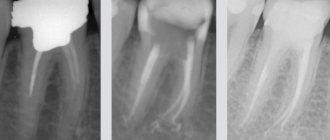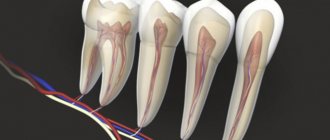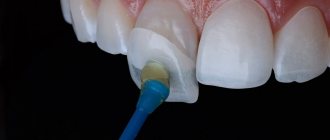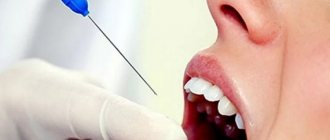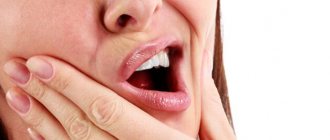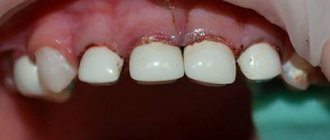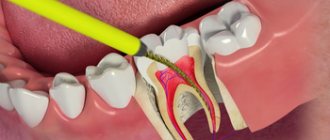Dental implantation is an effective solution for those who have lost one or more teeth. With its help, you can restore a beautiful and healthy smile, as well as stop bone atrophy. However, this method of treatment scares some people away because of possible complications, but they can be avoided if you know what we are talking about and how to do it.
In this material we will talk about what complications can occur after dental implantation. Let's immediately divide them into 2 groups:
- Natural, completely normal, appearing as a result of surgery and tissue injury. They do not pose a threat to the patient’s health.
- Dangerous complications that require immediate medical attention. They are the result of an incorrectly performed operation or indicate problems in the body.
| Good to know! According to statistics, the risk of serious postoperative complications causing implant rejection is extremely small and amounts to only 1-2%. |
Why does my upper lip go numb?
Physiological and cosmetic reasons
The appearance of the symptom is provoked by eating too cold or too hot food.
Numbness can also be a consequence of previous irritation of the upper lip from pepper or hot spices. At the same time, similar sensations are observed on the tongue and oral mucosa. The symptoms quickly disappear after stopping contact with the product. At sub-zero temperatures, strong winds, and high humidity, lips easily become chapped and crusty. Crusts impair the perception of tactile stimuli by nerve receptors, so their formation is accompanied by a feeling of numbness, which is complemented by a feeling of tightness due to a decrease in the elasticity of the skin, and the appearance of cracks.
In women, a decrease in lip sensitivity can be explained by individual intolerance to cosmetics (lipstick, lip gloss). Local itching, burning, and signs of skin irritation are possible. In some cases, the symptom is caused by an incorrect tattooing procedure or errors in lip care in the first days after manipulation.
Dental pathologies
One of the most common causes of numbness in the upper lip is diseases of the teeth and gums. The symptom is especially noticeable in severe inflammatory processes, accompanied by severe swelling of the oral mucosa and soft tissues of the face. It is provoked by gumboil, periodontitis, and gingivitis. In addition, numbness of the lip is observed after dental procedures performed under local anesthesia.
Trigeminal nerve injury
Isolated numbness of the upper lip rarely develops and is caused by trauma to the small branches of the n. maxillaris for bruises and open wounds of this anatomical area. A more common sensory disorder, simultaneously covering the upper part of the cheek, the side surface of the face, the outer corner of the eye, and the lower eyelid, is caused by damage to the trunk n. maxillaris, which is the second branch of the trigeminal nerve. It is found in fractures of the upper jaw, zygomatic bone, and compression by tumors.
Numbness of the upper lip
Migraine with aura
In patients with migraine with aura, an attack of cephalgia may be preceded by a transient loss of sensitivity in the hand, spreading to half the face and upper lip. Subsequently, the attack proceeds as usual. There is a throbbing or pressing pain in half of the head, nausea, slight dizziness, high sensitivity to bright light, loud sounds.
Cerebrovascular disorders
Numbness of the upper lip and other parts of the face and body is part of the clinical picture of a transient stroke or stroke. The symptom occurs against the background of headache, weakness, nausea, vomiting, vegetative-vascular manifestations (trembling, sweating, hot flashes), short-term disturbance of consciousness. Hemiparesis, decreased strength of certain muscle groups or one limb, facial asymmetry, and speech impairment are possible.
Hypoglycemia
Numbness of the lip is sometimes detected in patients suffering from severe diabetes mellitus; it develops as a result of severe hypoglycemia when using too high doses of insulin or poor diet. Combined with pallor, sweating, tachycardia, hand tremors. There are feelings of fear, excitement, followed by drowsiness, confusion, and fainting. Without help, coma is possible.
Quincke's edema
Numbness is caused by rapidly increasing swelling of the eyelids, cheeks, upper and lower lips. Quincke's edema forms against the background of an acute allergic reaction upon contact with pollen, animal hair, food, and other allergens. May be a consequence of pseudo-allergy. The condition develops suddenly within a few minutes, less often – hours. Hypoesthesia is often combined with skin itching, lacrimation, the appearance of copious nasal discharge, and difficulty breathing.
Herpes zoster
The cause of the pathology is the virus that persists in the body and causes chickenpox. Shingles symptoms may appear many years or even decades after the viral infection. The upper lip, as well as other parts of the face, become numb due to trigeminal neuritis. Typically, simultaneous involvement of the intercostal nerves, a rash along the affected nerve trunks.
Multiple sclerosis
The disease often manifests itself as weakness in the legs, combined with sensitivity disorders. Numbness and paresthesia are detected in the face, upper lip, torso, and limbs. There is a high probability of developing optic neuritis with reversible vision loss. Subsequently, with multiple sclerosis, paresis, symptoms of cerebellar damage, pyramidal disorders, and dysfunction of the pelvic organs are observed.
Pernicious anemia
The disease is caused by a disorder of hematopoiesis due to a deficiency of vitamin B-12. Manifested by weakness, tachycardia, dizziness, pale skin, puffiness of the face. Possible hypoesthesia of the upper lip, other areas of the face or limbs, and gait changes associated with neurological disorders. A characteristic sign of pernicious anemia is a “lacquered tongue.”
Neuroses
Loss of sensation in various parts of the body most often occurs in patients with hysterical neurosis. The patients’ complaints do not fit into the picture of a specific somatic pathology and are distinguished by pretentiousness and unusualness. Numbness of the upper lip is also sometimes seen in people with anxiety disorders. It may be part of the clinical picture of a panic attack or occur when the level of anxiety increases.
How it manifests itself
Paresthesia after tooth extraction should not be confused with the effect provided by the anesthetic. The latter passes without a trace in 4-6 hours. The development of complications is indicated by:
- numbness of part of the face (the patient complains
that a separate area becomes as if plastic, hard); - running “goosebumps” all over the cheek;
- unpleasant burning sensation;
- painful sensations.
These symptoms may last from several days to several months. Sometimes it is possible to get rid of them only after a year. In the latter case, it is customary to talk about a persistent or chronic form of the disease.
Diagnostics
Determining the cause of numbness is the responsibility of a neurologist. Due to the possible connection between upper lip sensitivity disorders and dental pathologies, a dentist is often involved in the examination. Sometimes a consultation with an allergist or endocrinologist is required. The diagnostic program includes the following methods:
- General inspection
. The doctor evaluates the patient’s appearance and the condition of the tissue at the site of the lesion. Identifies signs of inflammation, traumatic injury, skin rashes, and other symptoms indicating the cause of numbness. - Dental examination
. Provides for the study of teeth and soft tissues of the oral cavity to detect caries, pulpitis, gingivitis, periodontitis, and other dental diseases. - Neurological examination
. Includes sensory and movement testing. The specialist asks the patient to close his eyes, stretch out his lips, bare his teeth, and stick out his tongue. Tests reflexes and muscle strength of the limbs. - X-ray of the tooth.
Informative for dental diseases, allows you to detect inflammatory processes, osteomyelitis, tumor lesions. According to indications, it is supplemented with other hardware diagnostic methods. - Tomographic techniques.
Effective for multiple sclerosis, stroke and cerebral circulation disorders. They help determine the location, volume and nature of the lesion, and choose the optimal treatment tactics. - Lab tests
. Necessary to confirm pernicious anemia, hypoglycemia in diabetes mellitus. To clarify the type of allergen that caused the development of Quincke's edema, allergy tests are performed.
Electroneuromyography
Complications after local anesthesia
The human factor plays a big role in dental procedures. Often, the inexperience or carelessness of a specialist leads to serious consequences.
General complications that arise during local anesthesia in dentistry can be of different nature:
- Discomfort at the needle insertion site. This is due to the drug being administered too quickly or too slowly.
- Hematoma at the injection site. The occurrence and growth of a hematoma indicates problems with blood vessels or an incorrect choice of the needle insertion site.
- Allergic reactions. Despite the fact that reactions to drugs are determined before anesthesia, cases of severe allergies to the composition of the anesthesia are not uncommon, especially if it consists of two or more components.
- Inflammation of the gums, development of infection. This case suggests that several mistakes were made during the procedure, as a result of which bacteria entered unprotected tissue and caused inflammation.
- Numbness of the facial muscles. The symptom is often complicated to the point of paresis, lack of control over facial expressions, inability to close lips, and sagging areas of the face.
Treatment
Pre-hospital assistance
Numbness due to the use of seasonings, hot and cold foods does not require treatment and goes away on its own. If the sensitivity of the upper lip has decreased due to the use of incorrectly selected cosmetics, you should give the skin a rest and then apply another product. For chapped lips, it is recommended to use hygienic lipstick and rich nourishing creams.
For mild allergy symptoms, it is permissible to take an antiallergic drug on your own; for toothache, use an analgesic. To determine the cause of numbness, you should consult a doctor. Progressive deterioration of the condition, severe headache, increased swelling and other alarming symptoms are an indication for urgent consultation with a specialist.
Conservative therapy
The list of treatment measures depends on the cause of the symptom. Taking into account the nature of the pathology, the following therapeutic methods are recommended for patients with numbness of the upper lip:
- Dental diseases
. Removal of dental plaque, professional teeth cleaning, and sometimes selective tooth grinding are required. Applications of anesthetics and medications with antimicrobial action, rinses, and oral baths are effective. - Migraine
. To eliminate cephalalgia, painkillers and NSAIDs are used; for persistent headaches, triptans are used. Prevention of attacks is carried out by prescribing anticonvulsants and antidepressants in long courses. - Herpes zoster
. The basis of treatment is acyclovir in tablets or solution for intravenous drip. The regimen is supplemented with dipyridamole to inhibit platelet aggregation, furosemide for dehydration, and homologous immunoglobulin to activate immunogenesis. - Pernicious anemia
. Lifelong therapy with vitamin B12 and treatment of the underlying disease that provoked hypovitaminosis (enzyme intake, deworming) are necessary. - Angioedema
. It is possible to administer glucocorticoids, antihistamines, antifibrinolytics, fresh frozen native plasma, androgens, and loop diuretics. - Hypoglycemia
. Therapy includes eating sweet foods, intravenous administration of glucose solution, adrenaline, glucagon or glucocorticoids, drugs to support vascular tone and cardiac activity. - Neurotic disorders
. Psychotherapy is indicated, sometimes in combination with the prescription of psychotropic drugs: antidepressants, anti-anxiety and sedatives.
Surgery
If the trigeminal nerve is damaged or compressed, a nerve suture, neurolysis, and tumor removal are required. In patients with injuries, osteosynthesis of the upper jaw or zygomatic bone may be indicated. Patients suffering from dental diseases undergo tooth extraction, treatment of pulpitis and periodontitis. Gingivoplasty, gingivectomy, flap surgery, and opening of an oral abscess are performed. In case of strokes, the creation of anastomoses, reconstruction of arteries, thrombolysis, and occlusion of aneurysms are possible.
Content:
- Why does paresthesia occur after tooth extraction?
- How it manifests itself
- How to treat 3.1. Medicines for paresthesia 3.2. Physiotherapy 3.3. Surgical treatment of paresthesia
- Why paresthesia needs to be treated
- How to avoid paresthesia
Sometimes surgery to remove a molar tooth leads to complications. If after it the tongue, lip, chin become numb, taste sensations disappear, they speak of paresthesia. In most cases, this unpleasant condition goes away on its own within one to two weeks, but it happens that it is not possible to do without special treatment.


